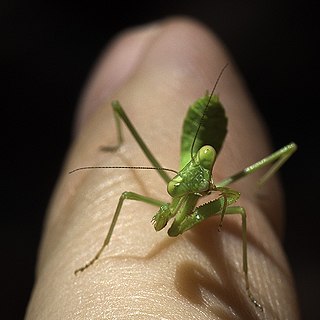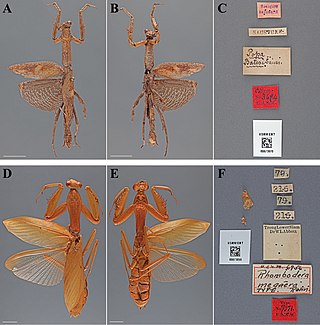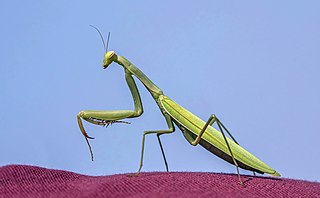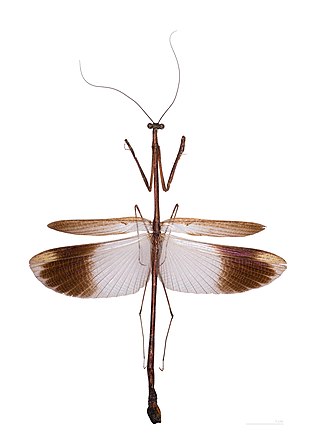
The Carolina mantis is a species of praying mantis of the subfamily Stagmomantinae.

The Chinese mantis is a species of mantis native to Asia and the nearby islands. In 1896, this species was accidentally introduced by a nursery tender at Mt. Airy near Philadelphia, United States. Tenodera sinensis often is erroneously referred to as Tenodera aridifolia sinensis because it was at first described as a subspecies of Tenodera aridifolia, but Tenodera sinensis is now established as a full species.

Mantidae is one of the largest families in the order of praying mantises, based on the type species Mantis religiosa; however, most genera are tropical or subtropical. Historically, this was the only family in the order, and many references still use the term "mantid" to refer to any mantis. Technically, however, "mantid" refers only to members of the family Mantidae, and not the 14 remaining families of mantises. Some of the most recent classifications have promoted a number of the mantid subfamilies to the rank of family, e.g. Iridopterygidae, Sibyllidae, Tarachodidae, Thespidae, and Toxoderidae, while other classifications have reduced the number of subfamilies without elevating to higher rank.

Tenodera is a genus of mantis in the family Mantidae which contains several species of praying mantises. The species in this genus can be found primarily in Africa, Asia and Australia, but also North America.

Iris oratoria, known by the common name Mediterranean mantis, due to humans first studying it in lands around the Mediterranean Sea, is a species of praying mantis. Its range is expanding in the Middle East, Western Asia and the United States.

Pseudovates chlorophaea, with the common name Texas unicorn mantis, is a species of praying mantis in the family Mantidae. It is native to the southern United States, Mexico, Central America, and northern South America.
Stagmomantis floridensis, common name larger Florida mantis, is a species of praying mantis in the family Mantidae. They are native to the south-eastern United States.

Stagmomantis is a genus consisting of 21 species of mantises native to the Americas.

Stagmomantis californica, common name California mantis, is a species of praying mantis in the family Mantidae that is native to the western United States.
Stagmomantis gracilipes, common name Arizona tan mantis, is a species of praying mantis in the family Mantidae. They are native to the south-western United States, Mexico and Central America.

Amphecostephanus is a monotypic genus of praying mantises in the family Chroicopteridae. It s represented by a single species, Amphecostephanus rex, that is found in Angola and Malawi. It was first described in "On some African Mantidae and Phasmidae in the Collection of the Deutschen Entomologischen Museum" in Archiv für Naturgeschichte, Berlin in 1912.

Stagmomantis limbata, common name bordered mantis, bosque mantis, Arizona mantis, or New Mexico praying mantis, is a species of praying mantis native to North America, most prevalent in the south-western United States. This beneficial insect is green or beige in color and grows up to around 3 inches long.

Rhombodera is a genus of praying mantises native to Asia and possessing common names such as shield mantis, hood mantis, and leaf mantis because of their extended, leaf-like thoraxes.

Rhombodera megaera is a species of praying mantises in the family Mantidae, found in China and Thailand.
Stagmomantis tolteca is a species of praying mantis in the family Mantidae.

Mantises are an order (Mantodea) of insects that contains over 2,400 species in about 460 genera in 33 families. The largest family is the Mantidae ("mantids"). Mantises are distributed worldwide in temperate and tropical habitats. They have triangular heads with bulging eyes supported on flexible necks. Their elongated bodies may or may not have wings, but all Mantodea have forelegs that are greatly enlarged and adapted for catching and gripping prey; their upright posture, while remaining stationary with forearms folded, has led to the common name praying mantis.

Angela guianensis is a species of praying mantis from the genus Angela of the family Mantidae. It was first described by the entomologist Rehn in 1906.

Angelidae is a family of mantises found in tropical Central and South Americas.

Pseudovates is a genus of praying mantis in the family Mantidae. There are more than 20 described species in the genus Pseudovates, and are found in North, Central, and South America.













